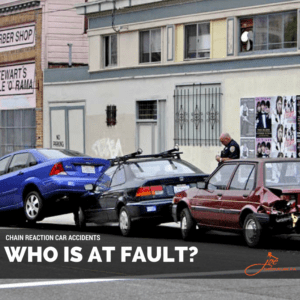Fault in ‘Chain Reaction’ Car Accidents
 Pensacola Car Accident Lawyer, Joe Zarzaur, explains some of the different issues that may arise — particularly when it comes to establishing fault — in Pensacola car accident cases involving chain reaction accidents.
Pensacola Car Accident Lawyer, Joe Zarzaur, explains some of the different issues that may arise — particularly when it comes to establishing fault — in Pensacola car accident cases involving chain reaction accidents.
Chain reaction auto accidents happen when three or more vehicles hit one another in a series of rear-end accidents that are caused primarily by the force of the first collision. Who is at fault?
Chain reaction wrecks account for 15% of traffic-related fatalities, causing an incredible 13,000 casualties a year. Many of these crashes take place on freeways where there is significant traffic congestion.
Here’s an example of a typical chain reaction accident:
Driver 4 –> Driver 3 –> Driver 2 –> Driver 1
Driver 2 rear-ends the car in front of him, which is being driven by Driver 1. Because Driver 3 was following Driver 2 too closely and could not stop in time, Driver 3 also rear-ends Driver 2. The same situation occurs behind Driver 3, with Driver 4 being unable to stop in time to avoid rear-ending Driver 3.
Bringing forth an insurance claim or personal injury suit against these types of accidents may pose a challenge because chain reaction accidents may involve many a variety of drivers who were potentially acting carelessly, to one degree or another. There’s a variety of issues that may arise, especially when it comes to establishing fault, in car accident cases involving chain reaction accidents.
Who’s Fault Was The Chain Reaction Car Accident?
You’ll have to prove liability under a legal theory called “negligence” if you file an insurance claim or lawsuit against another motorist after a chain reaction accident. In order to conclude which driver was negligent one will have to determine which driver’s carelessness caused the accident — or, if more than one driver was negligent, determining each driver’s share of liability.
Drivers must leave a safe following distance between their vehicle and the vehicle in front of them, so that they can stop in time to avoid any road hazards or unexpected situations, such as the lead car slamming on its brakes. A driver who fails to maintain a safe following distance and then rear-ends the lead car will almost always be considered negligent.
Chain reaction accidents are extremely dangerous because there is often more than one threat to your safety. In a quick second, the roadway becomes an obstacle course and everyone is trying to avoid a major collision, which creates confusion that ends up leading to more collisions.
In order to establish the order of impacts and determine who was careless, there are a number of sources Pensacola car accident lawyer, Joe Zarzaur utilizes. These include:
- eyewitness accounts (including your own, those of the passengers in each car, passers-by, and the drivers of the cars behind you)
- police reports of the accident, including findings as to whether any driver committed a traffic violation
- vehicle damage
- evidence at the scene of the accident, including skid marks and vehicle debris.
For help navigating each step of an insurance claim or lawsuit after a car accident, contact Joe Zarzaur at Zarzaur Law, PA in Pensacola, Florida. You will want to consult an experienced personal injury lawyer to make sure your legal rights are protected.